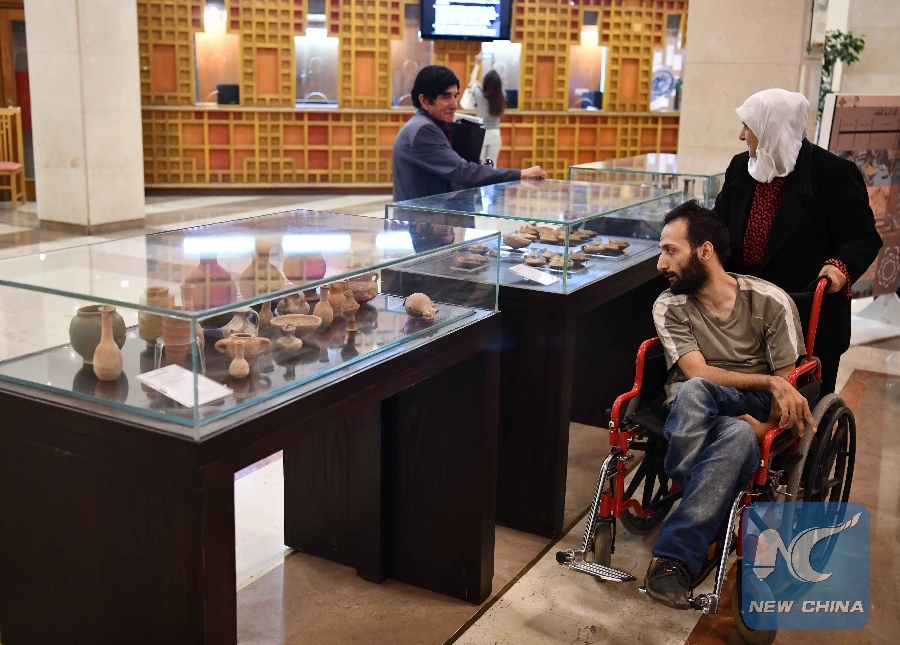
A Syrian woman takes a "selfie" photograph with her phone next to artefacts recovered by the government from archaelogical sites affected by fighting across the country, on display at an exhibition in the capital Damascus on October 3, 2018. (AFP photo)
DAMASCUS, Oct. 5 (Xinhua) -- As the Syrian army has captured much of the country's falling areas, archaeological pieces, either illegally excavated by the militants or damaged during the war, are under the restoration process.
More than 9,000 pieces, found from almost all Syrian areas, were delivered by the Syrian army and allied forces to the antiquities departments to be restored and returned to the museums.

Restored antiquities are put on display during an exhibition held in the capital Damascus on Oct.3. 2018. (Xinhua/Ammar Safarjalani)
The Antiquities and Museums Department in Damascus held a 10-day gallery, showing 500 of the restored pieces, including golden coins, bronze statues and amphorae, dating back to different historical eras from the tenth century B.C. to the Islamic era.
Director General ofAntiquities and Museums Mahmoud Hammoud told Xinhua that the restored antiquities were brought in by the Syrian army after liberating several areas, noting that many of the pieces were discovered as a result of the illegal excavations by the militants.
"The gallery showcases 500 pieces of antiquities out of 9,000 pieces that have been restored by the Syrian army and its allies as well as the different security apparatuses from areas that have been liberated from rebels," he said.
He added that tens of thousands of antiquities were discovered through the illegal excavations in the archeological sites that had been controlled by the terrorist groups and other militant groups.
Hammoud said when the army liberated the rebel-held areas, the artifacts were found in the command centers of the rebels and they were later brought to the museum and antiquities department of Damascus.
For his part, Khalil al-Hariri, head of the Museum of Palmyra, told Xinhua that some of the ancient busts and sculptures damaged when the Islamic State stormed the ancient city of Palmyra in central Syria are being repaired.
He said that the restoration process now is limited to the small pieces, noting that the large ruins and relics such as those damaged in the millennia-old Palmyra city need massive efforts and help from foreign countries.

Restored antiquities are displayed during an exhibition organized by the Directorate-General of Antiquities and Museums in Damascus, Syria, on Oct. 3, 2018. (Xinhua/Ammar Safarjalani)
Three of the busts were showcased in the gallery, and when the entire work finishes, the pieces will be returned to their respective museums across the country.
The restoration process has also been done with the participation of archeology students who are applying what they have studied in restoring some of the pieces.
Ovelia Kiwan, an archeology student, said she was tasked with repairing some of the ancient pieces of jewelry, in front of a stand showing colorful bracelets that she repaired.
"This is extremely important for us. We clean these pieces and restore them as well as conduct studies about them. This allows us to study the history more," she said.
The effort to restore the antiquities is still on the local scale as those findings were left by the rebels and could not be smuggled outside the country.
However, there is a fact that the militants succeeded in smuggling an unknown number of antiquities outside Syria to neighboring countries such as Lebanon, Jordan, and Turkey. From those countries, some of the pieces were smuggled to Europe.
In previous remarks, Hammoud said that around 16,000 Syrian ancient pieces are in Turkey.
As the diplomatic relation is still alive between Lebanon and Syria, some of the antiquities were returned from Lebanon to Syria.
Aside from the stolen artifacts, five out of the six Syrian archeological sites registered by the UNESCO as a World Heritage had sustained damage during the long-standing war in Syria.
The only site that has escaped the war is the old Damascus site.

